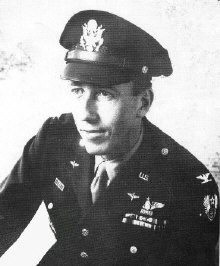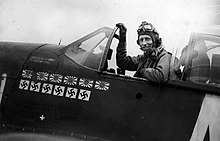
The First American Volunteer Group (AVG) of the Republic of China Air Force, nicknamed the Flying Tigers, was formed to help oppose the Japanese invasion of China. Operating in 1941–1942, it was composed of pilots from the United States Army Air Corps (USAAC), Navy (USN), and Marine Corps (USMC), and was commanded by Claire Lee Chennault. Their Curtiss P-40B Warhawk aircraft, marked with Chinese colors, flew under American control. Recruited under President Franklin Roosevelt's authority before Pearl Harbor, their mission was to bomb Japan and defend the Republic of China, but many delays meant the AVG first flew in combat after the US and Japan declared war.
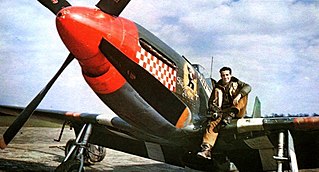
Dominic Salvatore "Don" Gentile, was a World War II RAF and USAAF pilot who achieved fame as he came close to surpassing Eddie Rickenbacker's World War I record of 26 downed aircraft. He later served in the post-war U.S. Air Force.
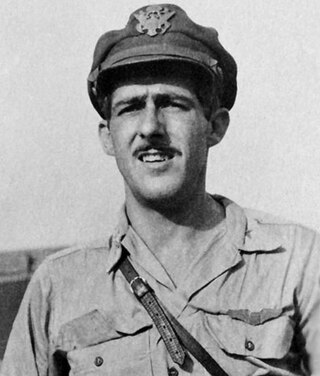
Thomas Buchanan McGuire Jr. was an American United States Army major who was killed in action while serving as a member of the United States Army Air Forces during World War II and posthumously awarded the Medal of Honor. He was one of the most decorated American fighter pilots and the second highest scoring American ace of the war.
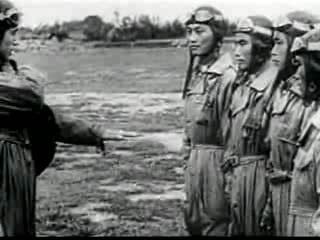
The Second Sino-Japanese War began on 7 July 1937 with the Marco Polo Bridge incident in the Republic of China and is often regarded as the start of World War II as full-scale warfare erupted with the Battle of Shanghai, and ending when the Empire of Japan surrendered to the Allies in August 1945. The Chinese Air Force faced the Imperial Japanese Army and Navy Air Forces and engaged them in many aerial interceptions, including the interception of massed terror-bombing strikes on civilian targets, attacking on each other's ground forces and military assets in all manners of air interdiction and close air support; these battles in the Chinese skies were the largest air battles fought since World War I, and featured the first-ever extensive and prolonged deployment of aircraft carrier fleets launching preemptive strikes in support of expeditionary and occupation forces, and demonstrated the technological shift from the latest biplane fighter designs to the modern monoplane fighter designs on both sides of the conflict.

George Earl Preddy Jr. was a United States Army Air Forces officer during World War II and an American ace credited with 26.83 enemy air-to-air kills, ranking him as the top P-51 Mustang ace of World War II and eighth on the list of highest scoring American aces.

Royal Air Force Halesworth or more simply RAF Halesworth is a former Royal Air Force station located 2 miles (3 km) north east of the town of Halesworth, Suffolk, England and 7 miles (11 km) west of Southwold.

Neel Ernest Kearby was a United States Army Air Forces colonel and P-47 Thunderbolt pilot in World War II who received the Medal of Honor for his actions in combat. Kearby is the first United States Army Air Forces fighter pilot to have received the Medal of Honor. He scored 22 aerial victories and was the top-scoring P-47 pilot in the Pacific Theater.

The 108th Operations Group is a unit of the 108th Wing of the New Jersey Air National Guard, one of the many units stationed at the McGuire AFB entity of Joint Base McGuire-Dix-Lakehurst, New Jersey. If activated to federal service with the U.S. Air Force, the group is gained by Air Mobility Command.
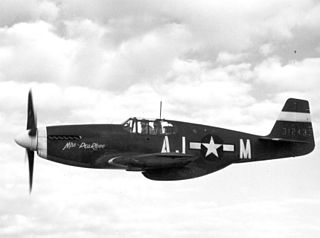
The 354th Fighter Group was an element of the United States Army Air Forces (USAAF) Ninth Air Force during World War II. The unit was known as the Pioneer Mustang Group and was the first to fly the P-51B Mustang in combat. The group served as bomber escort in the European theater of operations until D-Day, then moved to France to support the drive to Germany.

Pinellas Army Airfield was a United States Army Air Forces installation during World War II, located 9.8 miles northwest of St. Petersburg, Florida.

Aerial ramming or air ramming is the ramming of one aircraft with another. It is a last-ditch tactic in air combat, sometimes used when all else has failed. Long before the invention of aircraft, ramming tactics in naval warfare and ground warfare were common. The first aerial ramming was performed by Pyotr Nesterov in 1914 during the First World War. In the early stages of World War II the tactic was employed by Soviet pilots, who called it taran (таран), the Russian word for "battering ram".

Gerald Richard Johnson was a World War II flying ace who flew for the United States Army Air Forces. Johnson commanded the 9th Fighter Squadron and 49th Fighter Group, and became the fourth ranking fighter ace in the Pacific during World War II. He ended his war career with 22 kills.

Glenn Todd Eagleston was a career officer in the United States Air Force and the leading ace of Ninth Air Force in Europe in World War II. Eagleston was credited with 18 1/2 victories, two probable victories, and seven damaged German aircraft. He also destroyed at least five enemy aircraft on the ground, while flying P-51 Mustangs with the 354th Fighter Group.

John Francis Thornell Jr. was a career officer in the United States Air Force and a World War II flying ace. He flew P-51 Mustangs and P-47 Thunderbolts with the 328th Fighter Squadron of the 352nd Fighter Group. He was the third highest scoring ace of 352nd Fighter Group, and one of the top USAAF aces of the European Theater of Operations and Eighth Air Force, with 17.25 aerial victories and 3 ground victories.

Thomas Joseph Lynch was a United States Army Air Forces lieutenant colonel and a flying ace of World War II. After joining the United States Army Air Corps in 1940, Lynch flew the Bell P-39 Airacobra with the 39th Pursuit Squadron. After the attack on Pearl Harbor, the squadron was deployed to Australia and then to Port Moresby in early 1942.
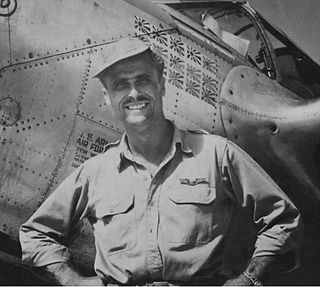
Robert Burdette Westbrook was a United States Army Air Forces lieutenant colonel and a World War II flying ace. Westbrook commanded the 44th Fighter Squadron, and became the leading fighter ace of the Thirteenth Air Force. He is also the ninth ranking fighter ace in the Pacific during World War II and also one of ten United States Army Air Forces pilots who became an ace in two different types of fighter aircraft.

Jack Tarleton Bradley was a United States Army Air Forces flying ace who was credited with shooting down 15 aircraft during World War II, being awarded the Distinguished Service Cross and the Distinguished Flying Cross for his actions. He served as commanding officer of the 353rd Fighter Squadron.

Stephen Jacob Bonner Jr. was an American flying ace in the 23rd Fighter Group during World War II.
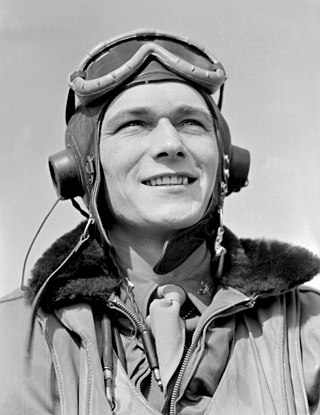
Donald Septimus Bryan was an American flying ace in World War II, who was credited with 13 aerial victories while serving with the 352d Fighter Group.

Perry John Dahl is a retired United States Air Force colonel and a flying ace, who was credited in destroying 9 enemy aircraft in aerial combat during World War II.
